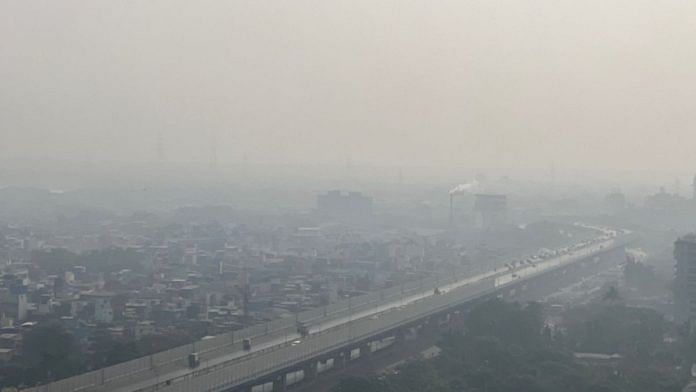Mumbai: For a decade, Delhi has been getting a bad rap for its poor air quality that chokes lungs, clogs throats, causes scratchy eyes, and leeches energy. But this year, Mumbai’s rising pollution levels have everyone gasping. The Arabian Sea, tropical humidity and the linear layout of the city have done little to dissipate the cloak of smog.
As Mumbaikars seethe in anger and the courts step in, the sledging and mud-slinging have become even more shrill. Political leaders, civic bodies, industries, factories, builders, motorists and even jewellers in Zaveri Bazaar in south Mumbai are all blaming each other. The surge in open-air garbage burning, traffic, waste from refineries and industries, and construction work is taking a toll on air quality.
“Mumbai, yeh kya ho gaya (Mumbai, what has happened to you)?” asked Indian cricket captain Rohit Sharma. He posted an aerial photo of the city covered in haze earlier this month on his Instagram story. On 1 November, he spoke to the media about it again.
“Obviously, looking at our future generations, our kids – my kid – it’s important that they get to live without any fear. Every time when I get to speak outside of cricket, if we are not discussing cricket, I always talk about this (pollution)… We have to look after our future generations,” he said. In January, Bollywood actor Sonam Kapoor tweeted about how “torturous” it was to live in Mumbai, referencing the traffic and air quality.
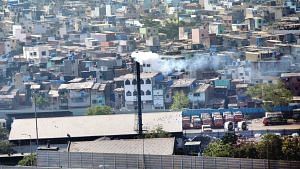
A worried Brihanmumbai Municipal Corporation (BMC) has issued ban upon ban in the past month. It has prohibited garbage burning, is cracking down on cement mixing factors, and is pulling up builders for flouting rules.
But what everyone has forgotten is that even in Mumbai, there are some neighbourhoods where the air is always toxic. The worst are the suburbs of Deonar and Govandi, where India’s largest garbage dump, spread over 300 acres with about 17 million tonnes of rubbish, rubs shoulders with a biomedical incinerator that was only recently shut down, illegal ready-mix cement plants and factories belching out smoke.
Since October, the Air Quality Index (AQI) here has worsened, even after pollution levels finally dropped in the rest of Mumbai following a slew of measures like a deadline for bursting crackers.
“The air quality index after the monsoon and starting October almost always lingers around 300 and above. We had put up AQI reading machines in our area, and compared to last year, the air quality is equally bad this year as per our studies,” said Faiyaz Alam Shaikh, founder of the Govandi New Sangam Welfare Society, a citizens’ collective that has been fighting for the right to clean air since 2020. Where the BMC failed, the collective is making some inroads. Last year, it successfully petitioned the Bombay High Court to get the medical incinerator relocated to the outskirts of the city.
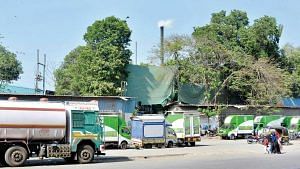
When it comes to air pollution, Govandi-Deonar is a magnifier for the rest of Mumbai. In the first week of November, when Mumbai’s AQI averaged 124, Deonar’s air quality index was almost 30 points higher. When its AQI is moderate, that of Govandi-Deonar is severe.
Residents of the slums around the dumping ground can’t remember a day when they weren’t breathing in methane, hydrogen sulphide, carbon monoxide, or the black smoke from the incinerator. In September, towards the fag end of the monsoons, when the rest of the city was breathing easier with a moderate/good AQI, Govandi’s was poor. In both localities, which abut each other, garbage burning goes on unchecked.
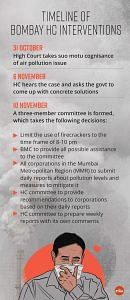
For its part, the BMC—which had set aside Rs 25 crore from its Rs 52,619 crore budget to fight air pollution—has introduced mitigation measures such as sprinkler systems and hyper-local monitoring of neighbourhoods across Mumbai. These measures are temporary band-aids at best.
“It is very naïve to think that by doing certain things in 10 days, the air pollution will be controlled. Air pollution mitigation needs technical know-how,” said Ronak Sutaria, founder of the non-profit Respirer Living Sciences.
For the Deonar dumping ground, the municipality is still considering setting up a waste-to-energy plant that will treat around 600 metric tonnes of garbage every day and generate 1.7 million units of energy annually. Even if it comes up, it’s too little too late, say activists and residents of Deonar Govandi.
Also read:
Air purifiers to the rescue
In the slums around Govandi, air purifiers are a status symbol, not plasma TVs and smartphones. Shaikh Irfan,45, had a unit installed in his one-room house where he lives with eight other family members, including his five-year-old child.
Irfan, who runs a fast-food stall in the area, can only breathe easy after he gets back home.
“My family doctor told me to install this filter machine at home because we were falling ill all the time. He said that with this machine, at least the air inside the house would remain clean,” he said.
For the first time, Irfan’s children don’t have a cough or cold this winter.
Every 10 minutes, trucks with Mumbai’s waste trundle into the Deonar landfill, belching black fumes on the way. Around 7,000-7,500 metric tonnes of solid waste is dumped into its landfills every day.
Also read: TV channel melodrama has its uses this week. It’s about Delhi air pollution
Sickness looms
A group of children play cricket and football in the small playground nearby. Having lived their lives in the sprawl of slums that surround the mountains of rubbish, they’ve become accustomed to the rank odour. Next to the playground is a government-run health clinic where mothers and children seek treatment for chronic cough.
Vegetable vendor Abdul Ansari is forced to visit the clinic every winter, when pollution in the city is at its peak. Govandi has always struggled with poor air quality, but he has seen a particular rise in the last four-five years. “Waste is constantly being burned here, and because of this, my eyes burn, and I have respiratory issues,” he says.
Dr Gauhar Ali, who has been running a private health centre in the area for about a decade, has seen more patients with respiratory ailments this year than ever. His tiny clinic is full of people with chronic obstructive pulmonary diseases (COPD), asthma and dry cough. He estimates that the number of patients he’s treated this year has increased by at least 30-40 per cent compared to last year.
“Every year, the air pollution becomes worse. On average, I treat 60-70 patients every day, and of this, 40 per cent come with air pollution-related issues,” said Ali, who has been residing in Govandi since childhood.
And then there is the dust.
“If you stand here for 10 minutes, your entire body will get covered with dust,” said Ansari, who sells vegetables on the main road leading to the dump. “The authorities and residents are both responsible for this.”
Mountains of rubbish—as high as perhaps an 18-storey skyscraper—tower over the jumble of huts and tenements that make up the slum. With a population density of more than 35,000 people per sq km (as per the 2011 census), the sprawl has expanded over the years as the mountains grow taller.
“At least 10 people live in small 10X10 ft rooms here,” said Ali.
According to Faiyaz Alam Shaikh, Govandi is the hotspot for tuberculosis due to its higher density and proximity to the dump. Through the New Sangam Welfare Society, he has sent emails to the BMC, the state health department, and the current and former chief minister, addressing the pollution issue in Govandi.
In an order on 11 September, the Bombay High Court directed the bio-medical waste plant, SMS Envoclean, to move farther out towards Patalganga MIDC. It’s a small victory for the residents.
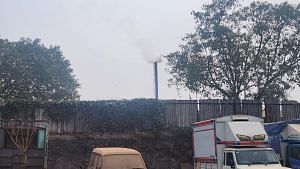
However, Amit Nalware, director of SMS Envoclean, refuted allegations that the plant is the main cause of pollution in the area.
“The pollutants we are emitting are half of our prescribed limits. We may be contributing, but so are the vehicles in the city,” said Nalware. He pointed out that when SMS Envoclean set up its plant, Govandi-Deonar was the outskirts—the back of beyond. “Houses came up in the area afterwards. We didn’t go in the residential area,” he added.
But it will be a while before the incinerator shuts down completely. The HC directed SMS Envoclean to commission the new incinerator facility within two years from the date of the order. In the meantime, the HC has directed that air pollution levels in the area as well as in the plant be monitored by the Maharashtra Pollution Control Board (MPCB) using not only “the online process but also by physical inspection of the site regularly.”
Mumbai’s pollution troubles
The slums clustered around the dumping ground give way to small factories and three to four-storey buildings. With every kilometre away from the landfill, the roads become wider, the buildings taller and the air cleaner. In the fringe are the upper-class localities and gated complexes, which give way to old bungalows and high rises on Govandi Road and Deonar Farm Road. Here, real estate prices (approximately Rs 30,000 per square foot) disregard the proximity to the factories and the dumping ground—sprawling views of the BARC hills make up for the eyesore.
This year, there was an outcry on the poor AQI from the suburbs to the island city. Mumbai’s air quality index did not touch 400 like in Delhi, but it kept the BMC and the MPCB on their toes.
The city’s famous coastline has always helped it keep pollution levels in check. But according to Dr Gufran Beig, founder and project director at SAFAR — a government agency that monitors air quality in major Indian cities – infrastructure projects like the metro and coastal road, the demolition of old buildings, the construction of towers, changes in wind speed, and increased vehicular emissions have contributed to rising pollution levels in the financial capital. According to BMC administrator Iqbal Chahal, construction activity is underway across 6,000 sites in the city.
Also read: Could cloud seeding help Delhi breathe easier? Here’s why it’s up in the air
Taking action
Mumbai experienced a similar crisis in October last year, following which the BMC allocated Rs 25 crore in the 2023-24 budget for the ‘Mumbai Clean Air Initiative’.
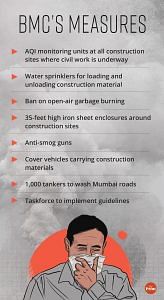
The plan outlined improved construction and demolition work practices, measures to reduce dust on roads, the importance of clean transportation and sustainable waste management, projects to promote urban greenery, effective air quality monitoring, and communication and awareness campaigns.
BMC also devised strategies to mitigate the ill effects of dust generated by construction and demolition activities. It instructed developers to install dust screens along the facade of buildings, use water sprinklers to settle dust clouds and use covered vehicles for transporting debris and construction material, among other things.
It looked good on paper, but the take-off has been bumpy.
“Ideally speaking, there should be long-term solutions, like a dedicated environment cell to monitor AQI changes. We must also temporarily stop construction activities if the weather does not permit,” says Beig. “But if these measures are implemented, there is no doubt it will yield results.”
In the last month, BMC has sprung into action. It has made it mandatory for builders to erect 35-foot high iron sheet enclosures around construction sites and cover under-construction buildings with green cloth or jute sheets on all sides to settle flyaways. Sprinkler systems at all construction sites have been made mandatory. The use of anti-smog guns, which, as the name suggests, dispel smog and absorb dust particles by spraying fine water droplets into the air, has also been encouraged at construction sites.
But the builders say they are being targeted. Earlier this week, the Confederation of Real Estate Developers’ Associations of India (CREDAI) Maharashtra Chamber of Housing Industry (MCHI) said that it was unfair to solely attribute rising pollution levels to heavy construction. Others claimed it was politically motivated, citing Uddhav Thackeray’s support for the real estate industry.
Later that week, the BMC started cracking down on the burning of waste in the open.
The BMC is also in the process of setting up a command-control centre to gather hyper-local data to tackle air pollution at the micro level. Contractors and real estate firms were served notices for not adhering to the pollution norms.
Earlier this month, the MPCB instructed Hindustan Petroleum Corporation Limited (HPCL), Tata Power and some logistics and chemical companies to cut down production by 50 per cent in order to curb pollution.
Earlier this week, BMC also served notices to gold and silver smelting units in Zaveri Bazaar, a popular jewellery market in Mumbai. They even demolished the chimneys of four such small-scale factories on the grounds that when “precious metals are melted in a furnace, gaseous byproducts are released into the air through chimneys.”
On 9 November, Maharashtra Chief Minister Eknath Shinde instructed the BMC to deploy 1,000 tankers to ‘wash’ Mumbai roads. He also asked municipalities to increase urban forested areas (Miyawakis) and ordered administrative bodies to collectively campaign for a pollution-free Maharashtra.
However, the opposition is not impressed.
“Every response of the ‘illegal CM’ to any issue is a ‘contractor-driven response’. Smog towers, sprinkler guns, [and] 1,000 tankers are not going to help,” said Aaditya Thackeray, Shiv Sena (UBT) MLA.
Describing the smog towers and the road washing plan as a “bogus scheme”, he criticised the Shinde government for failing to enforce these measures. It would help if the CM’s “builder and contractor friends” actually followed air pollution guidelines, Thackeray said.
Not just Mumbai; cities like Nagpur and Pune have also had a moderate-poor AQI since mid-October.
Considering the worsening air quality in several cities, the Maharashtra health department issued an advisory asking people to avoid outdoor morning and late evening walks, running, jogging and physical exercise in case of a “poor-severe” AQI.
According to Sutaria of Respirer Living Sciences, what Mumbai needs is a dedicated board or commission that will only concentrate on air pollution mitigation.
“These authorities are regulating and monitoring this issue, which is like saying the exam paper is written and checked by the same person,” said Sutaria.
Mumbai is on a top 10 list of the world’s most polluted cities, alongside Delhi, Lahore and Kolkata. Mumbaikars fear that it will only get worse.
The Eastern Express Highway takes motorists directly to the glitzy Bandra Kurla Complex. The ramp-up offers views of the Mithi River and the mangroves, which metamorphose into a Manhattan-like landscape as one moves onto the down ramp. But on Thursday morning, all the views from this four-year-old flyover were tired and smudged, like images that an unclean camera lens would yield. Haze, smog and the whiff of putrid air greeted motorists.
Faiyaz Alam Shaikh is getting more worried by the minute. “If government plans aren’t executed properly, even Mumbai can go the Delhi way in terms of pollution.”
(Edited by Zoya Bhatti)


